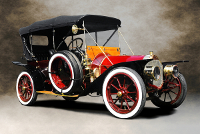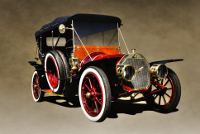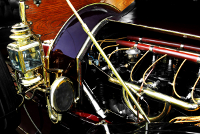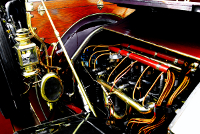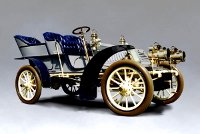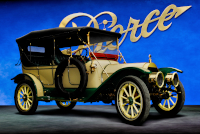Location:
Radnor Hunt Concours d'Elegance, 2007
Owner: James Grundy | Horsham, Pennsylvania
Prologue:
Over the years, I have updated this profile many times—discussing the car's place in collector car history, the difference between the tonneau and touring models, the cryptic Pierce-Arrow model designations through the most complex of production series. I've reworked old photographs and experimented with extra stock that simply is not good enough to publish. But the car really does represent a nexus of stories and trends that ultimately rippled outward from Pennsylvania to the broader car community. Modest though it may seem, this Model 36-UU embodies collector car history in general. And so it stands to reason I would find so many points to correct and to update in the course of building a Pierce-Arrow portfolio. In this case the images are secondary, whereas the story is pivotal.
- - - - - - - - - -
► Image Source 1-5: Nikon D200 (10.2 MP)
References:
- Ralston, Marc. "Pierce-Arrow" A.S. Barnes & Co., Inc., San Diego, CA. 1980, page 35-36, 230
- Ralston, Marc. "Pierce-Arrow, The Golden Age" Jostens Publications, Clarksville, TE. 1984, page 20
- "Automobile Quarterly's World of Cars," Kutztown Publishing Co. Inc., Kutztown, PA, 1971, page 208-209, 211; adapted from "Pierce-Arrow: An American Aristocrat" by Maurice D. Hendry, Volume VI, Number 3
- Grundy Insurance: A pivotal artifact in the history of classic car culture, and long owned by the Grundy family, this Pierce-Arrow sits at the center of the company's history.
- Hemmings: "The Infallible Pierce - 1909 6-36-UU" by David Traver Adolphus, March, 2011
- Pierce-Arrow Society: An online resource with many articles, history through "the Glidden Tour Years" is a good place to start.
1909 proved an important transitional year for the George N. Pierce Company. For starters, the Pierce motorcar officially became the Pierce-Arrow. Secondly, this would be the final year for the firm's four-cylinder offerings. President William Howard Taft also ordered two Pierce-Arrows in 1909, the first of many that would serve US presidents up to Franklin D. Roosevelt.
Of six chassis offered in 1909, the Model 36-UU fitted the lower end of the group; it is the least of four six-cylinder models Pierce-Arrow offered for the 1909 production cycle. However, the majority of production consisted of the 24-T four-cylinder in its final year, then the 36-UU, 48-SS, and 60-QQ, all six-cylinder cars.
The Birth of the Collector Car in the United States
This particular Model 36-UU was discovered, acquired, and restored by Mr. Sam Baily, Jr., son of the Sam Baily who founded the Pullman Automobile Company of York, Pennsylvania. Following divestment of Pullman, Sam Jr. went on to produce refrigerated truck bodies, work that included shells for Good Humor Ice Cream trucks. Waste generated from production brought him to the scrap yards of Philadelphia, where he once spotted this Pierce-Arrow on a pile, ready to be dismantled. On that trip, he exchanged the scrap for the car. The Pierce-Arrow returned to his factory where he and his company restored it.
Recognizing the historical value of the car, Baily's team documented the restoration—this occurred during the pre-War era, when auto restoration wasn't considered a discipline, and furthermore returned no investment value. Locally, however, the lately restored Pierce-Arrow generated interest among his friends, and Baily began finding and restoring other veteran cars. These cars and their owners would become the core contingent of the 14 founders of the Antique Automobile Club of America. So in no small way, the history of car collecting in America begins with this 1909 Pierce-Arrow.
The story turns a bit more incredible when Baily's daughter marries James A. Grundy, fresh back from World War II. Grundy begins an insurance company and soon pursues his father-in-law, hoping to insure the truck body factory. Sam Baily's stipulation on the deal is that Grundy also insure his collection of vintage automobiles. And since Baily has spent considerable money in their restoration, he wants the cars insured for their fully invested value.
To do so requires that the insurance company agree that the cars are not apt to depreciate, and that they can maintain their value based on the money invested in them, or perhaps even appreciate. Acknowledging that this information has been provided by what is today the very well known Grundy Insurance Company, it is yet worth noting that this deal represents a cornerstone of the collector car market. The point is not so much that someone appraised an old car for its value as a restored artefact, but that an insurance company agreed with the appraisal.
During his ownership, Sam Baily and his wife Mabel drove this Pierce-Arrow on numerous club events, including the Glidden Tour. In period, Pierce-Arrow had become widely known for winning the Glidden Tour five years running, beginning in 1905, which secured the company's reputation for durability. Not surprisingly, in later iterations of the event, the Baily family would travel more than 2,500 miles, not only completing the Tour, but driving there and back. Today, this Pierce-Arrow often resides in the Grundy company lobby, though it still gets its exercise from time to time.
Motor: 4,916 cc (300 cubic inch) straight 6-cylinder in three cast iron blocks | 100 mm x 120.65 mm
Valvetrain: T-head, single-plug
Power: 36 rated hp @ 1,700 rpm
Drivetrain: floor-shift, four-speed selective sliding-gear manual transmission, rear-wheel drive
Front Suspension: I-beam axle, semi-elliptic leaf springs
Rear Suspension: torsion rods, three-quarter elliptic leaf springs
Architecture: cast-alloy body on pressed manganese steel rear-drop frame
Kerb Weight: 1,445.6 kg (3,187 lbs)
Wheelbase: 3,022.6 mm (119 inches)
Etymology:
In 1908 the Pierce automobile officially became the Pierce-Arrow, the 'Arrow' moniker no longer a model name. The model designation is a combination of the number of cylinders and horsepower rating of the motor, determined by the Association of Licensed Automobile Manufacturers. 'Tonneau' is French carriage-speak for the rear seat section, and translates to 'barrel' in English. The tonneau moniker will lose favor over the next few years in deference to the touring car. The main difference is the shape of the bulkhead, which on a tonneau body is curvaceous, whereas the touring car employs a broad, flat shape. The style of this particular car has been called miniature tonneau and toy tonneau, owing to its shorter wheelbase and smaller stature.
The 'UU' designation follows an odd alphanumeric system that began respectably in 1901, but became cagey by 1909. In this case, Pierce developed the Model 30-U from 1908 to 1909, of which few seem to have survived. The 'U' likely followed in succession after 'Q,' 'S', and 'T' had been assigned to other platforms in the same production series. The subsequent development of the Model 36 brought about the revised 'UU' designation to replace the Model 30-U, doubling the letter as was Pierce-Arrow custom. Now in the present day, the Model 36-UU is prevalent, so one naturally wonders where the 'UU' came from for want of knowing (or ever seeing) a Model 30-U. So perhaps the sequence works, because Pierce-Arrow developed seven different models from 1908 to 1909, and the alphanumeric assignments probably match a chronology known by the engineers at the factory. But the sequence is difficult to follow without a comprehensive data sheet. And for that matter, they did skip the letter 'R.'
Figures:
Pierce-Arrow produced 307 of the Model 36-UU in 1909.
Value:
Original cost of the Model 36-UU in 1909, top-included, would have been around $4,175, roughly two or three times what would have been considered a very good annual salary, and well above the average worker's means. Top-of-the-line Pierce-Arrows were twice as expensive.
Aluminum Coachwork: Early Pierce-Arrow Advances
Pierce-Arrow panels may look like standard fare, but the company used a pioneering aluminum casting process for all of its bodies. The rigidity of this method meant that Pierce-Arrows did not rattle like typical period cars. Instead of layering sheet metal on wooden frames, the entire structure is formed of casts that are cold-riveted together. Note that as this Model 36-UU is a Miniature Tonneau, the body uses a tall, curved bulkhead to connect the passenger compartment to the bonnet, as opposed to a flattened bulkhead on Touring models.
Wings Up: Pierce-Arrow Running Gear Shape in the Brass Era
Notable on this particular car are the flares in the front and rear fenders, which give a Mercedes-like look. The addition of ski-type rear fenders first appeared in the 1909 Pierce-Arrow production cycle on smaller touring cars, whereas the front fenders typically (though not exclusively) remained rounded as on cars from the previous years. The winged front fenders on this Model 36-UU are therefore a specific to a lower, lighter platform.
Conservative Cars: Right-Drive Pierce-Arrow Cars
Note the right-hand driving position, which Pierce-Arrow held onto until 1921, when they were just about the last manufacturer to resist left-hand drive. The company itself was famously conservative in its technical ethos: Build straightforward mechanicals to the best possible quality, and do not spin off into fads of style and multi-cylinder bliss just because it might read better in an advert. This way of thinking is how a company can make its coachwork exclusively from aluminum casting, when no one else would think of doing so, but not bother to move the driver to the left side when the rest of the continent already has. Not surprisingly, this ethos would be the company's greatest strength, and also its downfall.
Last Updated: Mar 26, 2025

